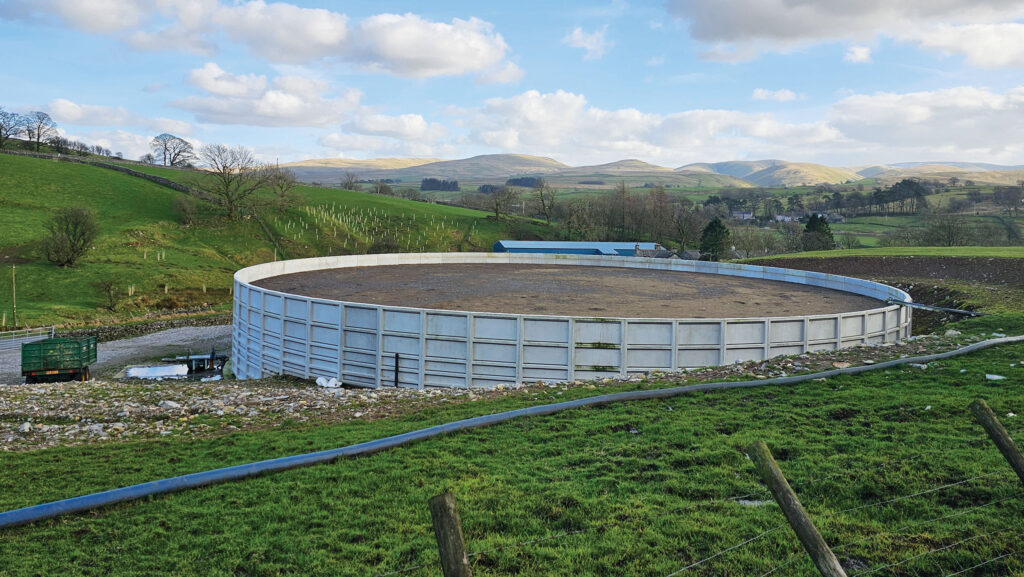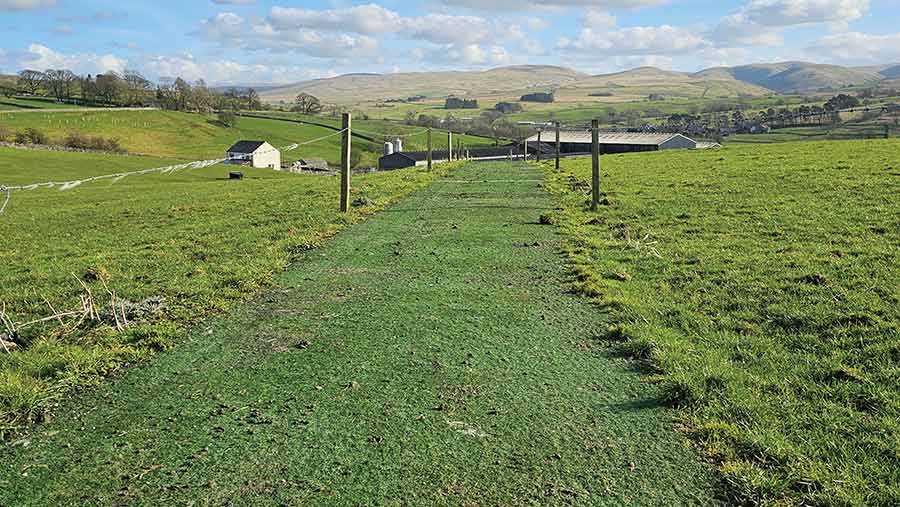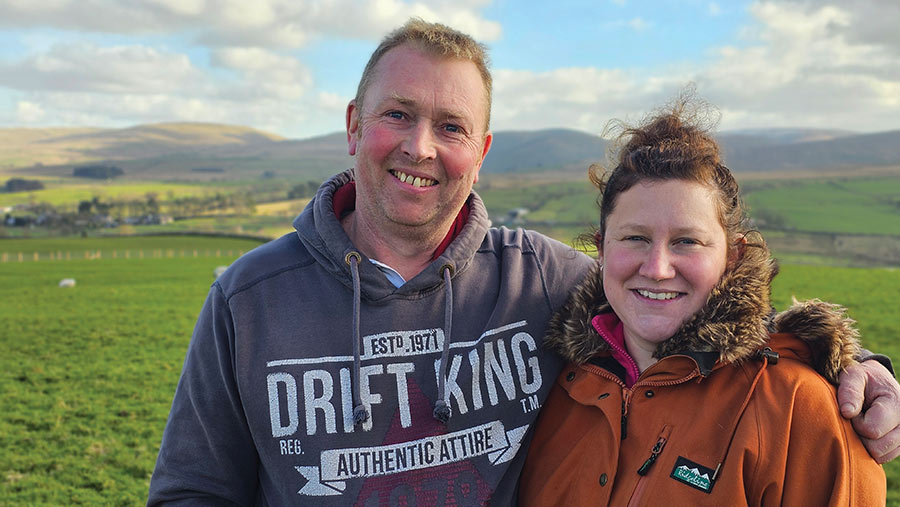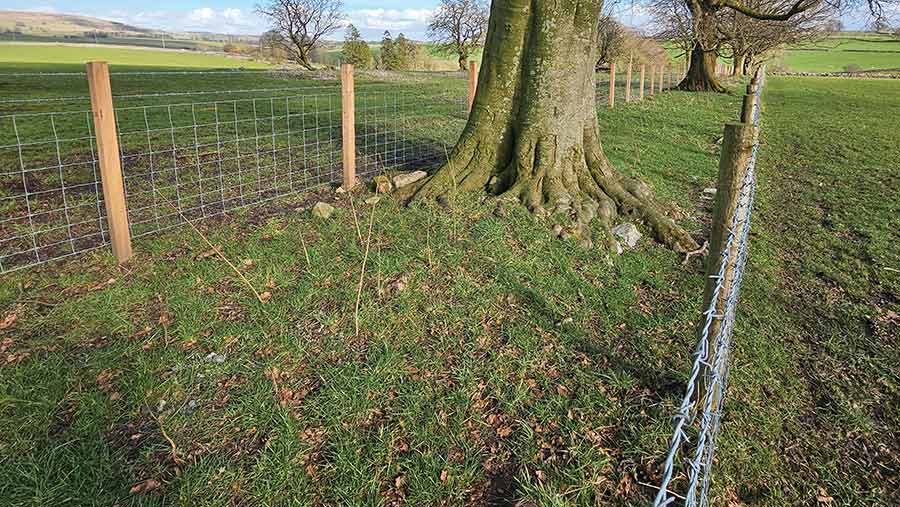How carbon audit kick-started dairy’s net-zero ambition
 Raisgill Hall Farm slurry tower © Sarah Alderton
Raisgill Hall Farm slurry tower © Sarah Alderton Improved slurry storage and an increase in milk from forage have helped a Cumbrian dairy farm cut its carbon footprint by one-third.
When the Dunning family first looked at Raisgill Hall Farm’s carbon footprint in 2012, it stood at 1.45kg carbon dioxide equivalent (CO2e)/litre.
By 2022, it had fallen to 1.19kg C02e/litre, and last year, it dropped below 1kg CO2e/litre, mainly by adopting regenerative farming principles such as rotational grazing and reduced fertiliser use.
See also: How one Ayrshire dairy is cutting its carbon footprint
The Dunnings milk 180 Holstein-Friesian cows year-round and supply First Milk on a Nestlé contract.
They say working on a 10-year plan with Nestlé has been one of the main driving forces behind the farm’s efforts to find ways to reduce its emissions.
Farm facts
Raisgill Hall Farm, Cumbria
- 180 Holstein Friesians, calving year-round
- Producing 8,430 litres at 4.61% butterfat and 3.24% protein
- Milk from forage 3,000 litres
- Calving index 372 days
- 128ha grazing, including 40ha rotational grazing platform
- Supplying First Milk on Nestlé contract
At a recent farm walk organised by The Farmer Network, Steve Dunnings, who farms with wife Barbara, son Mike, and daughter-in-law Lottie, explained that, in many cases, changes did not need to be major to see efficiency benefits.
“For dairy farmers, reducing emissions comes down to improving production efficiency by producing more from less, [and] focusing on things such as calving interval and calving in at two years old,” he said.
The Dunnings say their first step towards net zero came from the farm’s carbon audit, which revealed efficiency gains could be made from:
- Reducing purchased feed costs and producing more milk from forage
- Reducing fertiliser costs
- Tightening the calving index.
More than 1,000 soil cores were taken from across the farm to a depth of 1m to assess the level of carbon sequestration.
This process will be repeated next year (four years on) to monitor progress. They hope the results will lower their carbon footprint even further.

© Sarah Alderton
Reducing fertiliser use
The family also get their soils tested annually for a nutrient management plan so they know what needs applying, and when.
This plan, alongside investment in a recent 1m-gallon slurry tower, mean they have been able to target fertiliser and slurry applications.
Mike says they have halved the amount of fertiliser they use by investing in more slurry storage.
“We now only apply 40 units of N/acre at the start of the grazing season. In the past, we could only store two weeks’ worth of slurry, but now we can hold it throughout the winter and target the slurry spreading in the spring and summer.

© Sarah Alderton
“This has been an easy win, and not only has it helped cut our emissions by reducing fertiliser use, but it is also helping grass grow.”
The Dunnings also applied 2t of lime this year across the 128ha (317 acres) of grazing land.
Rotational grazing
The farm has moved from set stocking to rotational grazing to make the best use of the grass.
With funding through the Farming in Protected Landscapes Programme (FiPL) and help from the Lune Rivers Trust, they have installed cow tracks across the 40ha (100-acre) rotational grazing platform.
The platform consists of 21 1.8ha (4.5-acre) paddocks. This is reduced to 16 paddocks earlier in the season when the grass grows faster. The milking herd grazes as one group.
Electric fencing divides the paddocks, and water troughs are strategically placed so cows can access them from various paddocks.
Although setting up this system was expensive, and the Dunnings admit they were worried it would not work, it has benefited the farm the most.
“We have now been able to increase our milk from forage from 2,000 litres to 3,000 litres, and the grazing period has extended by up to a month,” says Mike.
“Traditionally, we would have buffer fed the cows earlier due to less forage. We are also producing a level milk profile throughout the grazing season.”
He says the cow tracks have also improved foot health and speeded up the process of bringing cows in for milking by 30 minutes.
“There are also big carbon advantages as we are not poaching the ground, and last year, the cows were still out grazing at the end of October,” he says, adding that the pastures are also proving to be more resilient.
Last August, they also experimented with herbal leys by direct-drilling a selected mix into about 3ha (7.5 acres).
“We found that whenever cows went into the paddock we had drilled, their milk increased by 300 litres. The plan is to introduce herbal leys into each paddock,” he explains.
Shelter and shade
The farm has planted more than 3,500 trees, as well as hedges and wildlife corridors, as part of its involvement in the local Orton Cluster Group.
“Once the hedges are established, they will provide shelter. In the summer, we found when cows had shelter from the sun, milk went up.

© Sarah Alderton
“Not only is this benefiting us by getting more points from Nestlé, but we will see direct benefits in the tank,” says Mike.
“Most of the trees have been planted on land that couldn’t graze cows, so we have not lost productive grazing land and are getting payments,” he adds.
Top tips for reducing emissions on dairy farms
Most farms probably have the answers to reducing carbon emissions on dairy farms, says Helen Dent of Kite Consulting. The challenge is proving it with data.
“It’s really important to get the data from the land, as you could be doing a lot of work without getting rewarded,” she says.
She advises testing the soils to set a base line: “When you test the soil, this will tell you how much carbon is stored. If that figure increases over time, then that is how much carbon your soils have sequestered.
“It takes at least four to five years to get a meaningful indication of sequestration.”
In a recent study of carbon emissions from 10 farms in Cumbria, funded by Eden District Council, Helen found the main emissions on dairy farms were from methane and feed production.
She also discovered that on many of the farms, although they had high soil carbon levels, soil pH was low, with variable phosphorus and potassium results.
“Where the pH is low, earthworms are low. Although soil fungi can operate at lower levels, bacteria and earthworms can’t,” she says.
“Soils also need a good pH for the release of nutrients. It needs to be 6.5 or above for maximum nutrient availability. If your soils reach pH 5, you have lost over half [of that].”
Aside from testing soils, Helen says some of the biggest wins for dairy farms in reducing emissions come from:
- Improving animal productivity
- Reducing age at first calving
- Improving the pH of soils
- Nutrient management planning
- Reviewing the diet, using home-grown forage and making better use of co-products
- Rotational grazing in appropriate situations
- Considering alternative cropping, clover and herbal leys
